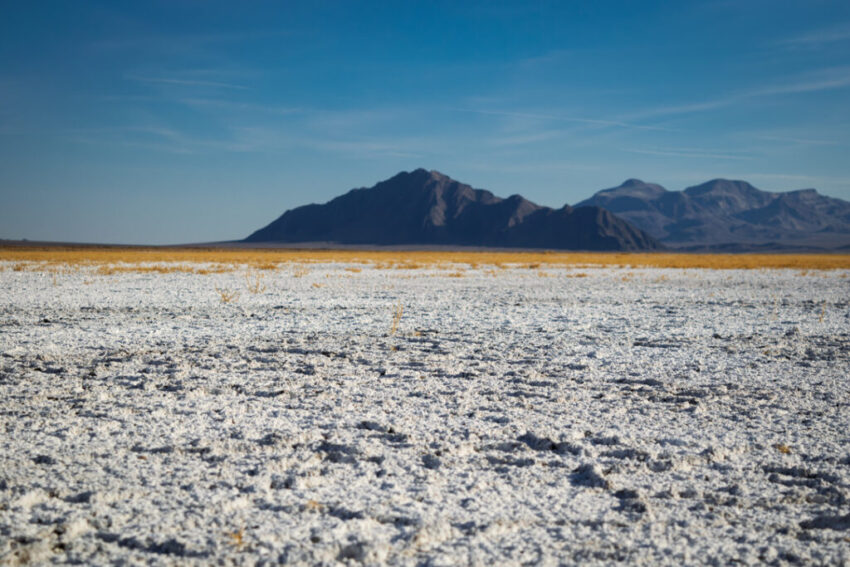Lower Carson Slough, looking toward Eagle Mountain (Photo: The Amargosa Conservancy)
Environmental groups are asking federal land managers to reverse a decision approving an exploratory drilling project near a desert wetland that provides a lifeline for migratory birds and endangered species.
Last month, the Bureau of Land Management greenlit a proposal by the St. Cloud Mining Company to drill up to 30 boreholes on public lands just north of Ash Meadows National Wildlife Refuge in search of clinoptilolite – a clay-like mineral used in water filtration, odor control, and soil conditioner.
Boreholes would be drilled just a few hundred feet away from the boundary of Ash Meadows, in an area of critical environmental concern that includes habitat for several rare and endemic species found nowhere else in the world.
Despite the project’s location, federal land managers concluded the project would have “no significant impact” on the environment and did not require a more in-depth environmental analysis before being approved.
Now a coalition of four environmental groups – the Center for Biological Diversity, Amargosa Conservancy, Friends of the Amargosa Basin, and the Sierra Clube Toiyabe Chapter – are asking the federal government to halt the drilling project while that decision is reviewed.
“These species and this landscape are direly threatened by mining exploration as proposed by St. Cloud Mining. If the St. Cloud project moves forward, it will cause irreparable harm to lands and waters in and around Ash Meadows and possibly drive these species toward extinction,” wrote Patrick Donnelly in a declaration to the BLM’s California state office.
St. Cloud Mining, which operates an existing mine nearby that was approved in 1987, did not respond to a request for comment.
In a letter to the California BLM director Joseph Stout, the coalition cites the project’s proximity to sensitive wildlife habitat, concerns with surface and groundwater resources and the impact to cultural sites, as reasons for concern.
The letter, which lays out evidence to support the groups’ request, says the federal government did not adequately analyze the project’s potential impact on wildlife, air quality, or water resources.
California BLM director Stout can affirm the original decision, reverse it completely, or modify it in part. If the request is denied, it can be appealed to the Interior Department’s Board of Land Appeals, or the environmental review could be the subject of a lawsuit.
Drilling will be limited to about one acre of surface area. The company plans to fill them up and replant seeds after exploration is complete. Any further construction would require further environmental review with an opportunity for public comment.
Federal hydrologists did acknowledge the company’s plan to drill boreholes up to 300 feet deep would likely hit groundwater due to the area’s shallow water table, a major concern for conservation groups.
Ash Meadows is home to a dozen federally protected species that rely on groundwater dependent springs, meaning any change to groundwater flow could be detrimental to them.
Exploration is typically the least environmentally damaging stage of mining, but even shallow drilling in the Amargosa Basin groundwater system can have severe, unpredictable, and far-reaching impacts.
Borehole Spring in Inyo County, California, near Tecopa Hot Springs, started as an exploratory drill hole dug by the Stauffer Chemical Company for sodium prospecting in 1967. After a driller punctured the aquifer at a depth of 350 feet, the Stauffer Chemical Company attempted to plug the leaking borehole, but steady water pressure kept eroding each successive well seal. A year later the cavity was filled with over 10,000 cubic yards of gravel, but the flow was never completely contained.
“St. Cloud’s proposed exploration project, by their own admission, will intersect groundwater. If their drilling activities cause a perturbation to the groundwater flow system, or worse, hit uncontrolled artesian flow, it could affect springs,” Donnelly wrote.
Still, federal hydrologists maintained it was unlikely the project would hit a pressurized water zone, adding that the risk of creating an uncontrolled water flow was low.
The drilling operation will also require somewhere between 20,000 – 40,000 gallons of water to be trucked in from either the Longstreet Inn in Amargosa Valley or Wolfenstein Construction in Pahrump.
Conservation groups noted that Ash Meadows is already threatened by groundwater pumping in the Amargosa Basin, due to water intensive dairy operations and alfalfa farming nearby. Residents of nearby Amargosa Valley have also reported domestic groundwater wells drying up near their homes.
Click this link for the original source of this article.
Author: Jeniffer Solis
This content is courtesy of, and owned and copyrighted by, https://www.nevadacurrent.com and its author. This content is made available by use of the public RSS feed offered by the host site and is used for educational purposes only. If you are the author or represent the host site and would like this content removed now and in the future, please contact USSANews.com using the email address in the Contact page found in the website menu.








